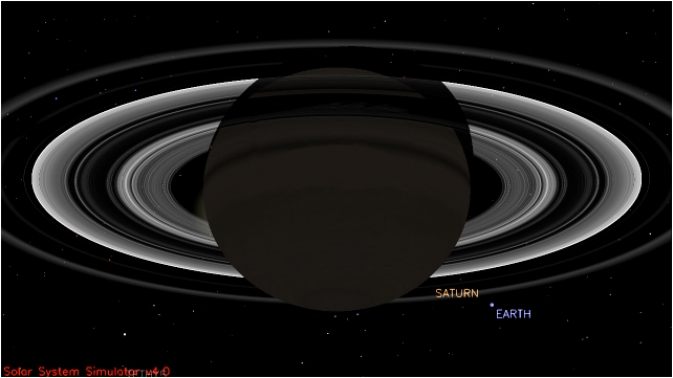No, it is not another NSA spying operation, it is NASA's Cassini and MESSENGER spacecraft, taking pictures of Earth from Saturn and Mercury.
The image taken from the Saturn system by Cassini will occur between 2:27 and 2:42 PDT (that's 5:27 and 5:42 p.m. EDT and 21:27 and 21:42 UTC) tomorrow, July 19th. Since Cassini is 898 million miles away from us, nearly 10 times the distance from the sun to Earth, it may not see you specifically but NASA is encouraging the public to get participatory and wave at Saturn at the time of the portrait and then pictures via social media.
Need to know how to find Saturn while it's still daylight and you are eating dinner? Science 2.0 is here to help. By that, we mean linking to NASA showing you how to find it.

Simulated view from NASA's Cassini spacecraft shows the expected positions of Saturn and Earth on July 19, 2013, around the time Cassini will take Earth's picture. Credit: NASA/JPL-Caltech
The Cassini Earth portrait is part of a more extensive mosaic of the Saturn system as it is backlit by the sun. The viewing geometry highlights the tiniest of ring particles and will allow scientists to see patterns within Saturn's dusty rings. Processing of the Earth images is expected to take a few days, and processing of the full Saturn system mosaic will likely take several weeks.

If you are on the west coast like me, look low on the eastern horizon from 2:27 to 2:42 p.m. PDT on July 19th, 2013. Obviously you can't see it in the daylight but that is Saturn’s approximate location. Credit: Jane Houston Jones
NASA's MESSENGER spacecraft in orbit around Mercury is coincidentally expected to capture Earth in some images taken in a search for natural satellites around Mercury on July 19th and 20th. Those images will be taken at 4:49 a.m., 5:38 a.m. and 6:41 a.m. PDT (7:49 a.m., 8:38 a.m. and 9:41 a.m. EDT, or 11:49, 12:38, and 13:41 UTC) on both days. Parts of Earth not illuminated in the Cassini images, including all of Europe, the Middle East and Central Asia, will appear illuminated in the MESSENGER images. MESSENGER's images also will take a few days to process prior to release.
If you take pictures and want to share them, you can obviously put them in a comment here. Or:
NASA on Facebook
NASA on Flickr






Comments